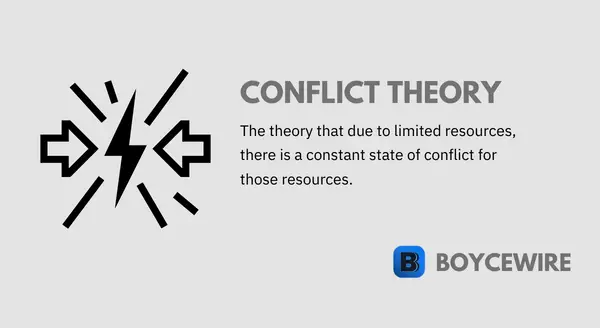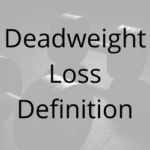Conflict Theory: Definition & Examples

What is Conflict Theory
Conflict theory refers to the state of constant conflict which is created by competition for limited resources. It was originally coined by Karl Marx and states that order can only be achieved by authoritarian power instead of voluntary co-operation and conformity.
Conflict theory stipulates that those who have wealth and power will do whatever they can to maintain it. At the same time, individuals will fight with each other in order to obtain it. This is apparent in the workplace whereby employees want to be paid more, whilst employers would like to pay them less.
Key Points
- According to Conflict theory, as wealth is amassed by the rich, the peasantry class would uprise to fight the injustice of inequality.
- There is conflict between groups or classes as they fight for limited resources.
- Marx’s Conflict theory segments society between socioeconomic lines, namely the proletariat working class, and the bourgeoise ruling class.
Conflict theory is largely a critique on capitalism. In centuries gone past, most humans had no real wealth – other than the monarchy. We were mostly farmers who worked purely for subsistence. Yet in the centuries gone by, and with the development of capitalism, wealth has been created, passed on, and amassed.
The argument that Marx had, was that wealth was needed to create more wealth, and those born without it were already behind. Those who had wealth were able to pass this on to future generations, who were then able to expand further on this wealth – creating further disparities in wealth.
Marx argued this would become a vicious cycle that would exasperate the income and wealth gap between the ‘haves’ and the ‘have nots’. In turn, this would lead to civil unrest as those who have little become tired of working for those with huge levels of wealth.
Conflict Theory Explained
Karl Marx believed that societies go through three phases – feudalism, capitalism, and then on to socialism. It is said that these phases are driven by economic inequality whereby the bourgeoise (rich capitalists), use the proletariat (working class) in order to obtain profits. The bourgeoise were widely outnumbered by the working-class proletariats, but held the power and wealth.
The bourgeoise would use their capital in order to exploit workers for their labor. As the proletariat only had their labor to sell, they were taken advantage of by the bourgeoise. As the proletariat became aware of this, conflict theory states that there will be an uprising whereby the workers have had enough and lead to a socialist revolution.
The nature of conflict theory can be explained by the two conflicting points of view from the bourgeoise and the proletariat. The bourgeoise are making profits and have wealth and power – so they are happy with the status quo. However, the proletariat are unhappy with their pay and conditions and therefore create conflict with the bourgeoise to change their position.
In turn, the conflict leads to an outcome which changes the current status quo. This might be higher pay for workers, better working conditions, or a complete collapse of the bourgeoise. This is known as the synthesis – which is the outcome whereby two conflicting opinions clash.
Conflict Theory Assumptions
There are four main assumptions of conflict theory – they are: competition, revolution, structural inequality, and war.
Competition
Competition is a natural state of human nature, as humans compete with each other for scarce resources. Conflict theory states this is at the heart of all social relationships. Instead of co-operation and consensus, humans are said to be in constant competition in a bid to win over resources. These resources may be as simple as money, but could also include promotion, relations, or other goods.
Due to the scarcity of resources, competition is a constant state of nature between humans who compete for them. This extends beyond normal resources such as money and include leisure time, power, social status, sexual partners, among others.
Revolution
Conflict theory assumes that there is a constant state of conflict between the social classes – the proletariat (working class) and the bourgeoise (ruling class). In turn, this constant conflict bubbles over and explodes into a revolutionary event. Evidence of such can be seen by the 1848 revolutions across Europe which ranged from France, the German states, and Denmark, to Spain, Sweden, and Switzerland.
Conflict theory states that the proletariat will get so worn down by their futile position, working for their masters, that they revolt. This is because their position has become so untenable that revolution is the only answer to their problems. Instead of small and gradual change, power is can only be removed and changed by force – leading to large, wide scale revolution.
Structural Inequality
Conflict theory highlights structural inequality as a key concept. It assumes that those who have wealth and power do their upmost in order to keep and retain it. They try to keep the social structure as it is. For example, it is stated that the bourgeoise would exploit the proletariat in order to profit and expand their wealth. Whilst those who had wealth and power got wealthier, those who had none were exploited.
If we take a modern-day example, it could be argued that big businesses lobby governments to lower taxes in order to maintain structural inequality. This way, the rich owners of the businesses maintain their position and power, whilst the proletariat lose through fewer public services.
War
Conflict theory assumes that war is an inevitable result of constant conflict where only war can resolve the underlying issues. It is said that war ‘cleanses’ society and helps unify. This is because war can completely alter the fabric of society. For example, the Second World War changed the world in a wide number of ways. It created a number of global organizations such as the UN and the EU, as well as a government public services such as the UK’s NHS and the public pension.
As a result of war, societies are changed rapidly due to the destruction caused. Conflict theory sees this as somewhat of a reset in society where it can step back and start from a new foundation.
Conflict Theory Examples
Occupy Wall Street
In 2011, Occupy Wall Street occurred following the financial crisis of 2008 and its subsequent economic turmoil. It’s slogan “We are the 99 percent” was in reference to the income disparities between the bottom 99 percent and the top 1 percent of earners. The main concern was the growing wealth disparities occurring in the US alongside the political influence that big multinational corporations were exerting on government.
One of the main concerns for protestors was that the top 1 percent saw rapid increases in income over the last 40 years. However, those on more moderate-income levels only saw minor wage increases. This leads onto conflict theory which states conflict occurs due to widening wealth disparities as the bourgeoise use the social structures to take advantage of the proletariat.
The movement has since expanded into other groups and areas as it seeks to improve working conditions and wealth disparities. This can be seen by the socialist shift by the Democrat party with the likes of AOC and Ilhan Omar.
#MeToo Movement
The MeToo movement originally started in 2006, but gained significant transaction in 2017 following sexual-abuse allegations against Harvey Weinstein. Following a report in the New York Times that a dozen women had made sexual-abuse claims against Weinstein, several high-profile celebrities followed suit. This included the likes of Gwyneth Paltrow, Ashley Judd, Jennifer Lawrence, and Uma Thurman.
The MeToo movement was significant as it highlighted the disparities and power gap of producers such as Weinstein. In the film industry, the power gap allows male producers to use that power to extract sexual favors from female actresses. As a result of competition for acting places, female actresses would sometimes oblige. However, others would not and would instead be offered a place as a form of ‘hush money’.
The movement gained transaction once it became apparent that a large number of females were abused at the hands of Weinstein. Others gained the confidence to come forward and share their story.
Race and Black Lives Matter
Racial tensions in America have been around for centuries and stretch back to the days of slavery. Yet whilst much has been accomplished in that time, there is still conflict between racial groups. This is because black Americans face unfair police treatment and on occasion, this has led to death. The 2020 death of George Floyd led to a number of riots across the country. Many people had had enough of this treatment of the black community and rose up in rebellion.
This is exactly what conflict theory would predict – as tensions between the black community and the police have been in constant conflict for years. It is argued that the policing community is systemically racist and are therefore suppressing the black working class – just as the bourgeoise did to the proletariat.
Rosa Parks
Another example of conflict theory lies at the heart of systemic racism. In 1956, Rosa Parks refused to give up her seat to a white person at the request of the driver. Segregation was commonplace at the time and she was required to move, but she refused and was later arrest for civil disobedience.
With relation to conflict theory, both blacks and whites were seen to be in competition for the same resources. In this case, it was the preferential treatment of a bus seat. This constant conflict which spanned areas far wider than the segregation on a bus – eventually boiled over upon Rosa Parks arrest.
The arrest of something so unwarranted helped put in motion the civil rights movement. This led to the Montgomery bus boycott, a number of ‘sit-ins’, and a wide range of civil disobedience which was largely peaceful. Whilst this never led to war or revolution, the conflict helped lead to change in segregation laws, which was eventually passed in 1968.
World War Two
The World War Two was largely a result of the severe economic punishment imposed on Germany after the conclusion of World War One. At the same time, there were severe economic consequences for the rest of the world. The First World War put significant financial pressure across the world and led to a number of dictatorships such as Mussolini in Italy, Stalin in Russia, and Hitler in Germany.
The constant conflict occurred as nations fought for resources. In the minds of the aforementioned dictators, resources could be found by invading other nations. This contributed to German expansion and hence the outbreak of World War Two.
Hitler would have not become so popular if it was not for the deepening economic divide which was caused by the Treaty of Versailles. Inequality was prevalent and this led to a power gap which Hitler was to eventually fulfil.
FAQs
Conflict theory is the idea that humans are in a constant state of conflict, driven by limited resources.
Examples of conflict theory include World War Two, Brexit, Rosa Parks and the Civil Rights movement, and Black Lives Matter.
Conflict theory is rooted in the works of Karl Marx, who focused on the class struggle between the bourgeoisie (capitalist class) and the proletariat (working class) under capitalism. However, modern conflict theory has been further developed by other sociologists, such as Max Weber, C. Wright Mills, and Ralf Dahrendorf.
Functionalism posits that society is a stable and harmonious system, with each part contributing to the overall functioning and stability of society. Conflict theory, on the other hand, emphasizes that society is characterized by tension, conflict, and inequality between different social groups competing for resources and power.
About Paul
Paul Boyce is an economics editor with over 10 years experience in the industry. Currently working as a consultant within the financial services sector, Paul is the CEO and chief editor of BoyceWire. He has written publications for FEE, the Mises Institute, and many others.

Further Reading
 Deadweight Loss: What it is, Formula & Examples - A deadweight loss is a loss in economic efficiency as a result of disequilibrium of supply and demand. In other…
Deadweight Loss: What it is, Formula & Examples - A deadweight loss is a loss in economic efficiency as a result of disequilibrium of supply and demand. In other…  Eminent Domain - Eminent domain is the legal power of a government to expropriate private property for public use, accompanied by the requirement…
Eminent Domain - Eminent domain is the legal power of a government to expropriate private property for public use, accompanied by the requirement…  Arithmetic Mean - The arithmetic mean, also known as the average, is the sum of a set of numbers divided by the total…
Arithmetic Mean - The arithmetic mean, also known as the average, is the sum of a set of numbers divided by the total… 
